| |
Valproic acid adjunctive therapy for HIV-associated cognitive impairment: A first report
|
| |
| |
G. Schifitto, D. R. Peterson, J. Zhong, H. Ni, K. Cruttenden, M. Gaugh, H. E.
Gendelman, M. Boska and H. Gelbard
From the Departments of Neurology (G.S., K.C., M.G., H.G.), Biostatistics
(D.R.P.), and Radiology (J.Z., H.N.), University of Rochester Medical Center,
Rochester, NY; and Departments of Pharmacology and Experimental
Neuroscience (H.E.G.) and Radiology (M.B.), University of Nebraska Medical
Center, Omaha.
Supported by NIH grants P01 MH64570, U01 AI27658, and R01 MH64409
and General Clinical Research Center grant M01 RR00044 from the National
Center for Research Resources, NIH.
Abstract- In vitro and animal model data demonstrate that valproic acid (VPA) can ameliorate HIV-associated neurotoxicity. The authors conducted a pilot 10-week placebo-controlled study of VPA 250 mg twice daily in 22 HIV-infected
individuals with (n =16) and without (n =6) cognitive impairment. VPA was safe and well tolerated, with trends toward improved neuropsychological performance and brain metabolism in the impaired subjects.
NEUROLOGY March282006;66:919-921
HIV-associated cognitive impairment remains frequent despite the use of highly active antiretroviral therapy (HAART), suggesting a need for adjunctive therapies. Our group has shown that HIV-1 neurotoxins including platelet-activating factor (PAF) and Tat activate glycogen synthase kinase (GSK)-3beta, a kinase directly implicated in the regulation of apoptosis, and that VPA inhibits apoptosis caused by PAF-induced GSK-3 activation.1 Furthermore, we have shown that VPA treatment significantly reduces phosphorylated beta catenin and tau levels and
protects against neuronal loss and dendritic simplification without affecting HIV replication or glial activation in a murine model of HIV encephalitis.2 Based
on these data, we conducted a double-blind, placebocontrolled pilot study of VPA in HIV-infected individuals to assess safety and tolerability and to explore
its effect on cognitive performance and brain metabolism.
Methods. Twenty-two eligible subjects, six without cognitive impairment and 16 with cognitive impairment, were enrolled and block-randomized within impairment strata to receive 250 mg VPA or placebo twice daily (table 1). Cognitive impairment was defined as performance at least 1 SD below the mean on two or
more neuropsychological tests or at least 2 SD below the mean on one neuropsychological test, using normative data previously applied by the Dana cohort.3 Subjects were evaluated at 2, 6, and 10 weeks for adverse clinical and laboratory experiences. Neuropsychological evaluations (table 2) were performed at screening, week 6, and week 10 along with global assessments of functioning (subject and investigator), the Fatigue Severity Scale,4 and the Center for Epidemiologic Studies Depression Scale. A neurologic examination and CD4/CD8 counts were performed at screening and week 10, while plasma HIV viral load was measured at baseline and week 10.
Proton (1H) magnetic resonance spectroscopy (MRS) and diffusion tensor imaging (DTI) were performed at baseline and week 10, using a 1.5-T General Electric Signa MRI scanner (with TwinSpeed gradients and EXCITE11 software). Single-voxel proton spectra were acquired from three locations in the brain: midline of the frontal lobes; right (or left) mid-frontal centrum semi-ovale; and right (or left) basal ganglia (BG), and relative peak areas of N-acetyl aspartate (NAA), creatine (Cr), choline (Cho), and myo-inositol (MI) were determined. The DTI protocol used to calculate fractional anisotropy and diffusion trace values
is reported in table 3.
Tolerability was assessed based on the proportion of subjects able to complete the 10-week study at the original dose of study medication. Safety measures included the occurrences of adverse events and abnormal results on laboratory tests. Measures of efficacy included changes from baseline in neuropsychological test scores, the Investigator Clinical Global Impression, MRI indices, functioning, and mood. The study was designed to provide approximately 80% power to detect a 45% difference in tolerability (i.e.,
95% vs 50%) between the placebo and VPA groups using a onesided Fisher' s exact test at the 5% level of significance.
Changes from baseline were assessed using paired t tests. Comparisons between treatment arms were based on unequalvariance, two-sample t tests for continuous variables and Fisher' s exact tests for categorical variables. Comparisons between treatment arms were adjusted for baseline values using analysis of covariance. Primary statistical analyses were performed according
to the intention-to-treat principle, using the last-observation-carried-forward imputation strategy for subjects who prematurely dropped out of the study. Secondary analyses excluded such subjects.
Results. Despite randomization, the VPA group was slightly more neurologically and functionally impaired at baseline (table 1), likely due to the small sample size. A higher percentage of patients in the control group were taking HAART than in the VPA group, possibly explaining the higher percentage of detectable plasma viral load in the VPA group (table 1). Baseline cognitive performance
(table 2) and MRS and DTI indices (data not shown) were comparable in the two groups.
Of the 22 enrolled subjects, one subject was randomized but discontinued study participation prior to receiving drug and was included only in the baseline analyses (table 1). Two subjects (one on placebo and one on VPA) completed
week 6 and did not return for week 10. Nineteen of the 21 subjects with longitudinal evaluation completed the 10-week study, 15 had MRS/DTI data both at baseline and week 10.
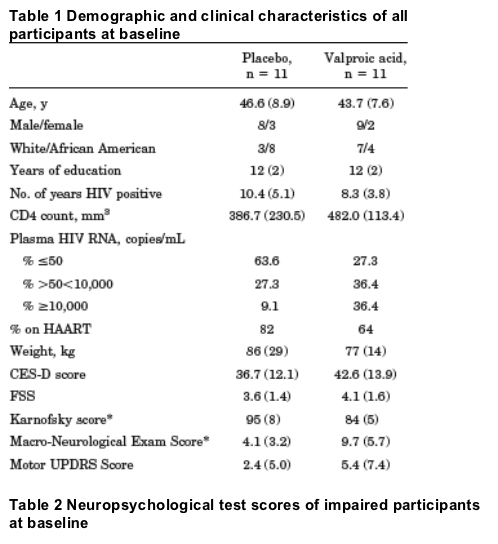
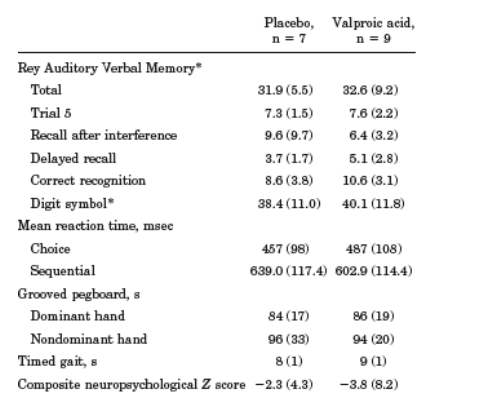
There were no significant safety laboratory changes from baseline to week 10 in either the placebo or VPA group. One patient on VPA had an increase in liver function tests 2.5 times the upper limit of normal at week 6; this patient did not return for week 10 assessments. Subsequent laboratory tests obtained from the primary care provider demonstrated a normalization of these values. A second patient on VPA reported mild new onset of acid reflux during the trial; however, this isolated adverse experience did not require suspension of study medication.
CD4 T-lymphocyte cell counts did not change significantly in either group from baseline to 10 weeks. Similarly, changes in plasma HIV RNA from baseline to week 10 did not differ significantly in the two treatment groups (see table E-1 on the Neurology Web site at www.neurology.org). Changes in cognitive performance among impaired subjects are reported in table E-2. Between-group differences on independent neuropsychological tests and the composite Z score were not significant, however, with the exception of the mean reaction time and trial 5 of the Rey Auditory Verbal Memory, all neuropsychological measures
including the summary Z score favored the impaired subjects in the VPA group. Similar results were found when the six unimpaired subjects were included in the analysis. No significant difference was seen in the investigator Clinical Global Impressions between the placebo and the VPA group.
There was a significant NAA/Cr increase in the frontal white matter (FWM) (p=0.006) of cognitively impaired subjects on VPA, but there were no significant changes in other MRS or DTI indices (table 3).
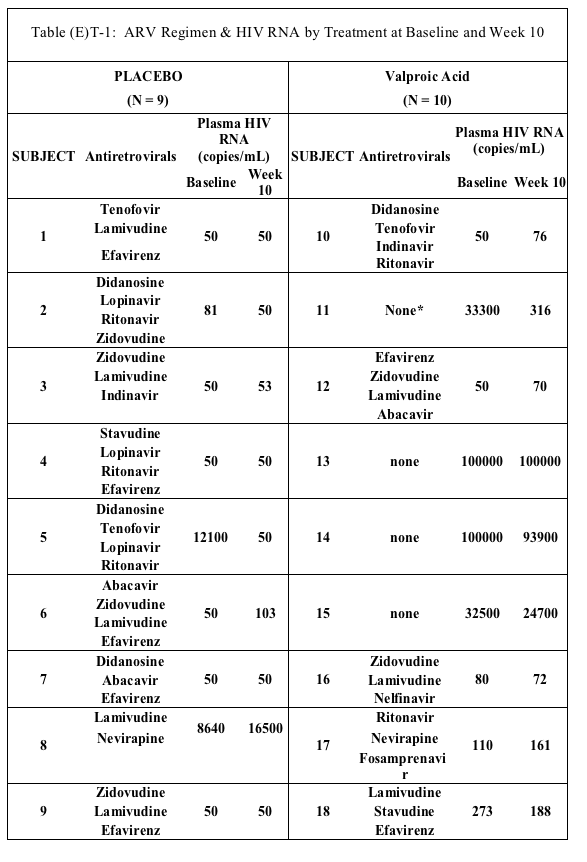

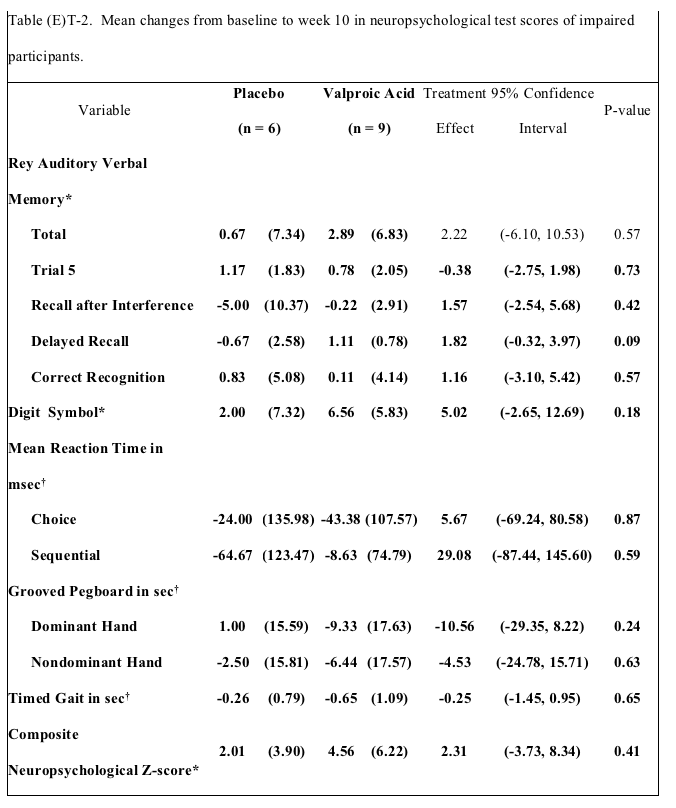

Table 3 Changes in mean treatment effects in MRS and DTI indices from baseline to week 10 in VPA vs placebo
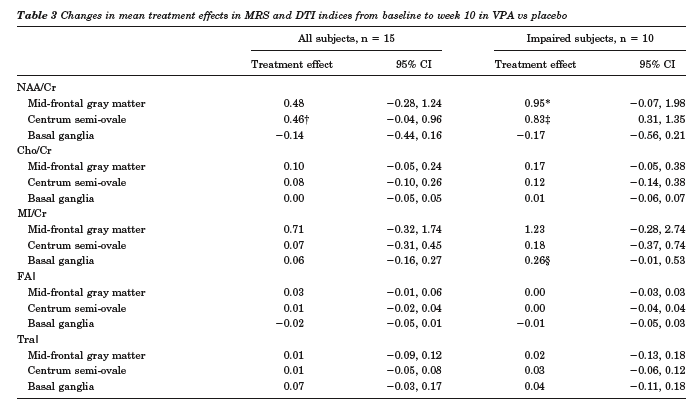
Treatment effect is the difference in mean change between the valproic acid group and the placebo group, adjusted for the baseline value in an analysis of covariance model.
* p=0.06; p=0.07; p=0.006; p=0.06 (measurements of myo-inositol and creatine concentrations indicate an increase in myoinositol and no change in creatine).
The DTI data were acquired with one T2-weighted image (b=0) plus diffusion-weighted (b =1,000 s/mm2) images along 21 different diffusion-encoded directions for each slice, using a spin-echo echo-planar imaging sequence (TR/TE =8000/85 msec).
NAA = N-acetyl aspartate; Cr = creatine; Cho choline; MI = myo-inositol (LC model software used for spectroscopic analysis); FA = fractional anisotropy; TR trace.
Discussion. Our data indicate that VPA at the dose of 250 mg twice daily was well tolerated and did not affect significantly either clinical or laboratory measures including CD4 lymphocyte cell count or HIV RNA plasma concentrations. This is reassuring given that early in vitro reports suggest that VPA may stimulate HIV replication.5 More recently, it has been shown that VPA given at 1000-1500 mg/day, in combination with antiretroviral therapy may decrease latent HIV infection in lymphocytes without affecting viremia.6 Although cognitive performance in the 10 weeks of treatment did not change significantly in the placebo group vs the VPA treated group, the overall trend was toward better performance in the VPA group when compared to the placebo group. Similarly, the significant increase in NAA/Cr in the frontal white matter (FWM) in the cognitively impaired subjects on VPA may be indicative of improvement, as a decrease in NAA/Cr in the FWM has been previously reported in HIV-infected
individuals with cognitive impairment when compared to healthy controls.7 Interestingly, HAART has been shown to improve MRS indices of brain metabolism, but only partially in regard to NAA/Cr in the FWM.8,9
The results of this pilot trial together with the results of our previous pharmacokinetic study10 sug gest that three important criteria have been met to
further investigate VPA in the treatment of HIV-associated cognitive impairment: VPA at 500 mg daily 1) does not lower exposure to antiretroviral therapy; 2) does not affect HIV RNA replication; and 3) is well tolerated by HIV-infected individuals. Furthermore, the trend toward improvement seen in cognitive performance and the significant increase in NAA/Cr in the FWM in the VPA-treated subjects are encouraging and warrant a larger and longer trial specifically designed to assess efficacy.
|
|
| |
| |
|
|
|